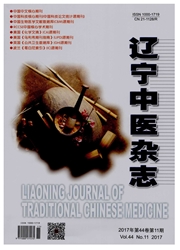

 中文摘要:
中文摘要:
目的:研究麻杏石甘汤对内毒素(LPS)致热模型大鼠血浆中内源性物质的影响。方法:25只大鼠随即分为空白组、致热模型组、低剂量组、中剂量组、高剂量组,每组5只。模型组及高、中、低剂量组动物分别以20μg·kg^-1体重的剂量尾静脉注射1μg·mL^-1内毒素溶液,空白组同法给予生理盐水(Ns)。造模后6h内测量大鼠体温,6h后,心脏取血。血浆预处理后,HPLC/MS/MS检测血浆中物质,PCA,OSC—PLS分析数据,分析潜在生物标记物。结果:各剂量组的最大体温上升高度△Tmax与模型组比较差异均有显著性(P〈0.05);在前两个主成分得分散点图中,中剂量、高剂量麻杏石甘汤对LPS致热大鼠血浆中内源性物质的影响较低剂量的影响要大,苹果酸,L—phenylalanine等物质在各组实验动物体内发生了相应的变化。结论:实验剂量麻杏石甘汤明显影响LPS致热大鼠血浆中内源性物质状态,苹果酸,L-phen—vlalanine可能是麻杏石甘汤对LPS致热大鼠血浆中内源性物质的影响的生物标记物。
 英文摘要:
英文摘要:
Objective:To study Maxing shigan Decoction(MXSGD) effect on endogenous substances of LPS induced fever rats. Methods :25 rats were randomly divided into control group, model group,low, middle and high dose groups ,5 rats in each group. Before low, middle and high dose groups and fever model group were induced fever by LPS, low, middle and high dose groups were administrated with MXSGD, the control and model groups were administrated with NS. The body temperature of rats was measured within 6 hours;the plasma samples were acquired and detected by LC/MS/MS. And data was analyzed by PCA,OSC -PLS. Results:Compared with model group, the maximal temperature of each dose groups was lower significantly(P 〈 0. 05 ). In the first two components scatter plot of PCA, the middle and high dose groups had the obvious difference from that of the model group. The further analysis indicated that the concentrations of malic acid and L - phenylalanine changed in different groups. Conclusion:The middle and high dose MXSGD had an important effect on the endogenous substances in plasma of the fever model rats. Malic acid and Lphenylalanine might be the possible biomarkers.
 同期刊论文项目
同期刊论文项目
 同项目期刊论文
同项目期刊论文
 期刊信息
期刊信息
